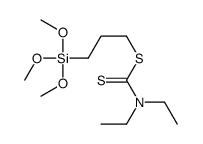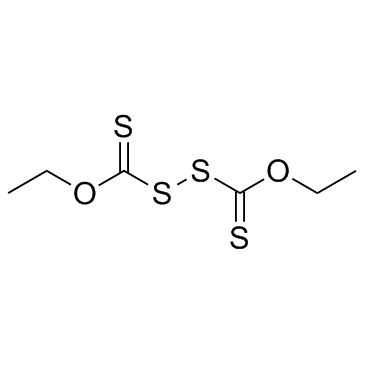148-18-5
| 中文名 | 二乙基二硫代氨基甲酸钠 |
|---|---|
| 英文名 | Sodium diethyldithiocarbamate |
| 中文别名 |
乙硫氮
DDTC钠盐 二硫卡钠 二乙胺荒酸钠 |
| 英文别名 |
EINECS 205-710-6
sodium,N,N-diethylcarbamodithioate Diethyldithiocarbamic acid sodium salt MFCD00041028 |
| 描述 | Ditiocarb sodium (Sodium diethyldithiocarbamate) 是一种铜试剂,与 Cu2+ 溶液反应,生成络合物,提高了铜置换沉淀速率。Sodium diethyldithiocarbamate 可降低 HIV 感染。 |
|---|---|
| 相关类别 | |
| 靶点 |
HIV[2] |
| 体外研究 | Ditiocarb sodium(二乙基二硫代氨基甲酸钠)与Cu2 +溶液反应,得到二乙基二硫代氨基甲酸铜络合物,提高了胶结速率[1]。 Ditiocarb sodium是一种具有很强抗氧化能力和螯合活性的药物[2]。 |
| 体内研究 | Ditiocarb sodium(二乙基二硫代氨基甲酸钠)可改善新生和老年小鼠的抑制免疫反应。二乙基二硫代氨基甲酸钠在不降低抗肿瘤活性的情况下防止动物中的顺铂肾毒性。在艾滋病模型中,Ditiocarb钠可以减少淋巴结病和高球蛋白血症,恢复免疫能力,延长生存期[2]。 |
| 参考文献 |
| 密度 | 1.086g/cm3 |
|---|---|
| 沸点 | 176.4ºC at 760mmHg |
| 熔点 | 95°C |
| 分子式 | C5H10NNaS2 |
| 分子量 | 171.259 |
| 闪点 | 60.5ºC |
| 精确质量 | 171.015228 |
| PSA | 60.63000 |
| LogP | 1.81060 |
| 外观性状 | 无气味的白色或略棕色或略粉红色晶体 |
| 储存条件 | 室温 |
| 稳定性 | 遇酸分离出二硫化碳可使溶液浑浊。遇明火、高热可燃。其粉体与空气可形成爆炸性混合物,当达到一定 |
| 水溶解性 | >=10 g/100 mL at 14 ºC |
| 计算化学 | 1.疏水参数计算参考值(XlogP):无 2.氢键供体数量:0 3.氢键受体数量:2 4.可旋转化学键数量:2 5.互变异构体数量:无 6.拓扑分子极性表面积36.3 7.重原子数量:9 8.表面电荷:0 9.复杂度:83 10.同位素原子数量:0 11.确定原子立构中心数量:0 12.不确定原子立构中心数量:0 13.确定化学键立构中心数量:0 14.不确定化学键立构中心数量:0 15.共价键单元数量:2 |
| 更多 | 1.性状:易溶于水,溶于乙醇,其溶液呈碱性。溶于甲醇、乙醇、丙酮,不溶于乙醚、苯。 2.熔点(ºC):95 |
Synonym:Sodium diethyldithiocarbamate trihydrate; Diethylcarbamodithioic acid sodium salt trihydrate; Dithiocarb trihydrate; DTC trihydrate; DDC trihydrate; DEDC trihydrate; DDTC trihydrate; DeDTC trihydrate; chelating agent with strong affinity for H Section 2 - COMPOSITION, INFORMATION ON INGREDIENTS
Risk Phrases: 22 Section 3 - HAZARDS IDENTIFICATION EMERGENCY OVERVIEW
Harmful if swallowed.Hygroscopic (absorbs moisture from the air). Potential Health Effects Eye: Causes eye irritation. Skin: Causes skin irritation. Ingestion: May be harmful if swallowed. Contact with stomach acid may liberate carbon disulfide which primarily affects the nervous, cardiovascular, and reproductive systems. Inhalation: Causes respiratory tract irritation. Chronic: May cause reproductive and fetal effects. Prolonged or repeated exposure affects the nervous system. Section 4 - FIRST AID MEASURES Eyes: Flush eyes with plenty of water for at least 15 minutes, occasionally lifting the upper and lower eyelids. Get medical aid immediately. Skin: Get medical aid. Flush skin with plenty of water for at least 15 minutes while removing contaminated clothing and shoes. Wash clothing before reuse. Ingestion: Do not induce vomiting. If victim is conscious and alert, give 2-4 cupfuls of milk or water. Never give anything by mouth to an unconscious person. Get medical aid immediately. Inhalation: Get medical aid immediately. Remove from exposure and move to fresh air immediately. If not breathing, give artificial respiration. If breathing is difficult, give oxygen. Notes to Physician: Section 5 - FIRE FIGHTING MEASURES General Information: As in any fire, wear a self-contained breathing apparatus in pressure-demand, MSHA/NIOSH (approved or equivalent), and full protective gear. During a fire, irritating and highly toxic gases may be generated by thermal decomposition or combustion. This material in sufficient quantity and reduced particle size is capable of creating a dust explosion. Extinguishing Media: Use water spray, dry chemical, carbon dioxide, or appropriate foam. Section 6 - ACCIDENTAL RELEASE MEASURES General Information: Use proper personal protective equipment as indicated in Section 8. Spills/Leaks: Vacuum or sweep up material and place into a suitable disposal container. Clean up spills immediately, observing precautions in the Protective Equipment section. Avoid generating dusty conditions. Provide ventilation. Section 7 - HANDLING and STORAGE Handling: Wash thoroughly after handling. Remove contaminated clothing and wash before reuse. Use with adequate ventilation. Minimize dust generation and accumulation. Avoid contact with eyes, skin, and clothing. Avoid breathing dust. Storage: Store in a cool, dry place. Keep container closed when not in use. Store protected from moisture. Refrigeration has been recommended. Section 8 - EXPOSURE CONTROLS, PERSONAL PROTECTION Engineering Controls: Facilities storing or utilizing this material should be equipped with an eyewash facility and a safety shower. Use adequate ventilation to keep airborne concentrations low. Exposure Limits CAS# 148-18-5: Germany: 2 mg/m3 TWA (inhalable fraction) Netherlands: 2 mg/m3 MAC CAS# 20624-25-3: Personal Protective Equipment Eyes: Wear appropriate protective eyeglasses or chemical safety goggles as described by OSHA's eye and face protection regulations in 29 CFR 1910.133 or European Standard EN166. Skin: Wear appropriate protective gloves to prevent skin exposure. Clothing: Wear appropriate protective clothing to prevent skin exposure. Respirators: Follow the OSHA respirator regulations found in 29 CFR 1910.134 or European Standard EN 149. Use a NIOSH/MSHA or European Standard EN 149 approved respirator if exposure limits are exceeded or if irritation or other symptoms are experienced. Section 9 - PHYSICAL AND CHEMICAL PROPERTIES Physical State: Crystalline powder Color: very slightly yellow Odor: Not available. pH: 11.6 (10% aq soln) Vapor Pressure: Not available. Viscosity: Not available. Boiling Point: Not available. Freezing/Melting Point: 95-98.5 deg C Autoignition Temperature: Not available. Flash Point: Not applicable. Explosion Limits, lower: N/A Explosion Limits, upper: N/A Decomposition Temperature: Solubility in water: Soluble. Specific Gravity/Density: Molecular Formula: C5H10NNaS2.3H2O Molecular Weight: 225.31 Section 10 - STABILITY AND REACTIVITY Chemical Stability: Stable under normal temperatures and pressures. Conditions to Avoid: Dust generation, moisture, excess heat. Incompatibilities with Other Materials: Strong oxidizing agents, strong acids. Hazardous Decomposition Products: Nitrogen oxides, carbon monoxide, oxides of sulfur, carbon dioxide. Hazardous Polymerization: Has not been reported Section 11 - TOXICOLOGICAL INFORMATION RTECS#: CAS# 148-18-5: EZ6475000 CAS# 20624-25-3: EZ6550000 LD50/LC50: CAS# 148-18-5: Oral, mouse: LD50 = 1500 mg/kg; Oral, rabbit: LD50 = 500 mg/kg; Oral, rat: LD50 = 1500 mg/kg; Skin, rat: LD50 = >1 gm/kg. CAS# 20624-25-3: Oral, mouse: LD50 = 1500 mg/kg; Oral, rat: LD50 = 1500 mg/kg. Carcinogenicity: Sodium diethyldithiocarbamate, anhydrous - Not listed by ACGIH, IARC, or NTP. Sodium diethyldithiocarbamate trihydrate - Not listed by ACGIH, IARC, or NTP. Other: See actual entry in RTECS for complete information. Section 12 - ECOLOGICAL INFORMATION Section 13 - DISPOSAL CONSIDERATIONS Dispose of in a manner consistent with federal, state, and local regulations. Section 14 - TRANSPORT INFORMATION IATA Not regulated as a hazardous material. IMO Not regulated as a hazardous material. RID/ADR Not regulated as a hazardous material. Section 15 - REGULATORY INFORMATION European/International Regulations European Labeling in Accordance with EC Directives Hazard Symbols: XN Risk Phrases: R 22 Harmful if swallowed. Safety Phrases: WGK (Water Danger/Protection) CAS# 148-18-5: 3 CAS# 20624-25-3: 2 Canada CAS# 148-18-5 is listed on Canada's DSL List. CAS# 148-18-5 is not listed on Canada's Ingredient Disclosure List. CAS# 20624-25-3 is not listed on Canada's Ingredient Disclosure List. US FEDERAL TSCA CAS# 148-18-5 is listed on the TSCA inventory. CAS# 20624-25-3 is not on the TSCA Inventory because it is a hydrate. It is considered to be listed if the CAS number for the anhydrous form is on the inventory (40CFR720.3(u)(2)). SECTION 16 - ADDITIONAL INFORMATION N/A |
|
毒理学数据: 急性毒性LD50大鼠,小鼠(mg/kg):2830,1870口服;小鼠:>1000静脉注射。 CHEMICAL IDENTIFICATION
HEALTH HAZARD DATAACUTE TOXICITY DATA
MUTATION DATA
|
| 危害码 (欧洲) | Xi |
|---|---|
| WGK德国 | 1 |
| 海关编码 | 2930909090 |
| 上游产品 0 | |
|---|---|
| 下游产品 10 | |
| 海关编码 | 2930909090 |
|---|---|
| 中文概述 | 2930909090. 其他有机硫化合物. 增值税率:17.0%. 退税率:13.0%. 监管条件:无. 最惠国关税:6.5%. 普通关税:30.0% |
| 申报要素 | 品名, 成分含量, 用途 |
| Summary | 2930909090. other organo-sulphur compounds. VAT:17.0%. Tax rebate rate:13.0%. . MFN tariff:6.5%. General tariff:30.0% |


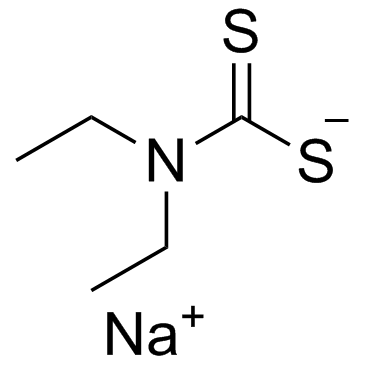
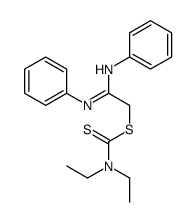
![[2-(4-methylanilino)-2-(4-methylphenyl)iminoethyl] N,N-diethylcarbamodithioate结构式](https://image.chemsrc.com/caspic/298/105858-90-0.png)
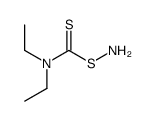
![[2-(4-ethoxyphenyl)imino-2-(4-methoxyanilino)ethyl] N,N-diethylcarbamodithioate结构式](https://image.chemsrc.com/caspic/146/105858-94-4.png)
![[2-(4-ethoxyanilino)-2-(4-methylphenyl)iminoethyl] N,N-diethylcarbamodithioate结构式](https://image.chemsrc.com/caspic/222/105858-92-2.png)
![[2-anilino-2-(4-methylphenyl)iminoethyl] N,N-diethylcarbamodithioate结构式](https://image.chemsrc.com/caspic/239/105858-87-5.png)

